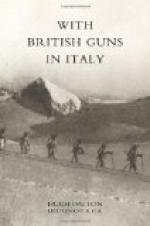But their difficulties were tremendous. When they left the valley of the Isonzo behind them, they entered a waterless land, without springs for some four miles. In the early stages of the battle all water for the troops had to be brought up by mules, and likewise all food, ammunition and medical supplies, until the Engineers could get to work with road-building on the left bank of the river. The Bainsizza Plateau itself, lying amid a mass of barren mountains, contains woods, pastures, springs, small villages, a few roads and many tracks. The Italians swept over it on the 21st and 22nd of August, but soon found themselves once more in difficult country. In the days that followed the advance was slower and more spasmodic, but it still continued. By the 27th, 25,000 Austrian prisoners had been taken, together with a great quantity of material, and several whole Austrian Divisions had ceased to exist.
It had been a wonderful feat of arms, finely conceived by the Staff, magnificently executed by the rank and file. It opened out a great vista of new possibilities, but, for the moment, it was over. Before any further advance was practicable, the positions won had to be consolidated, roads had to be built, dumps and stores of every kind to be moved forward.
* * * * *
In a village on the Bainsizza Plateau, half wrecked by shell fire, two old peasants were sitting outside their house. Austrian shells whistled through the air and burst a few hundred yards away. “These are not for us,” said one of the old men to an Italian soldier, “the shells and the war are for the soldiers, not the civilians.”
CHAPTER XVIII
THE FIGHTING DIES DOWN
On the 28th of August the offensive was really beginning again. We were firing on San Marco at a slow rate from six a.m. for an hour, then “vivace” from seven till noon, and at noon we lifted and continued vivace. San Marco was not rocky, and the trenches there should be bombardable into pulp. In the early morning from Sant’ Andrea the hills all round were clearly outlined, except where some long belts of motionless, white, low-lying cloud partly hid the Faiti-Stoll range. Later, with the sun up, a warm haze hid everything. Firing continued heavy till six p.m., and then slowed down. The attack on San Marco had failed.
Next day there was a good deal of shelling and some torrential showers. We set fire to some woods on the lower slopes of San Daniele, with a high wind blowing.
* * * * *




